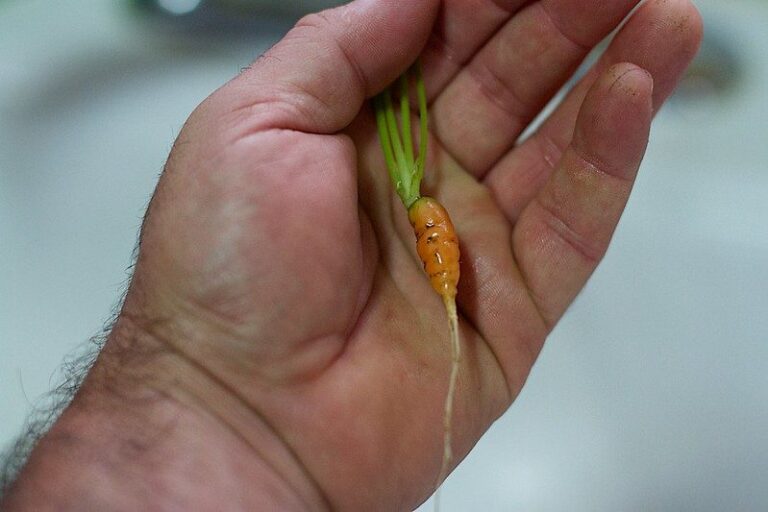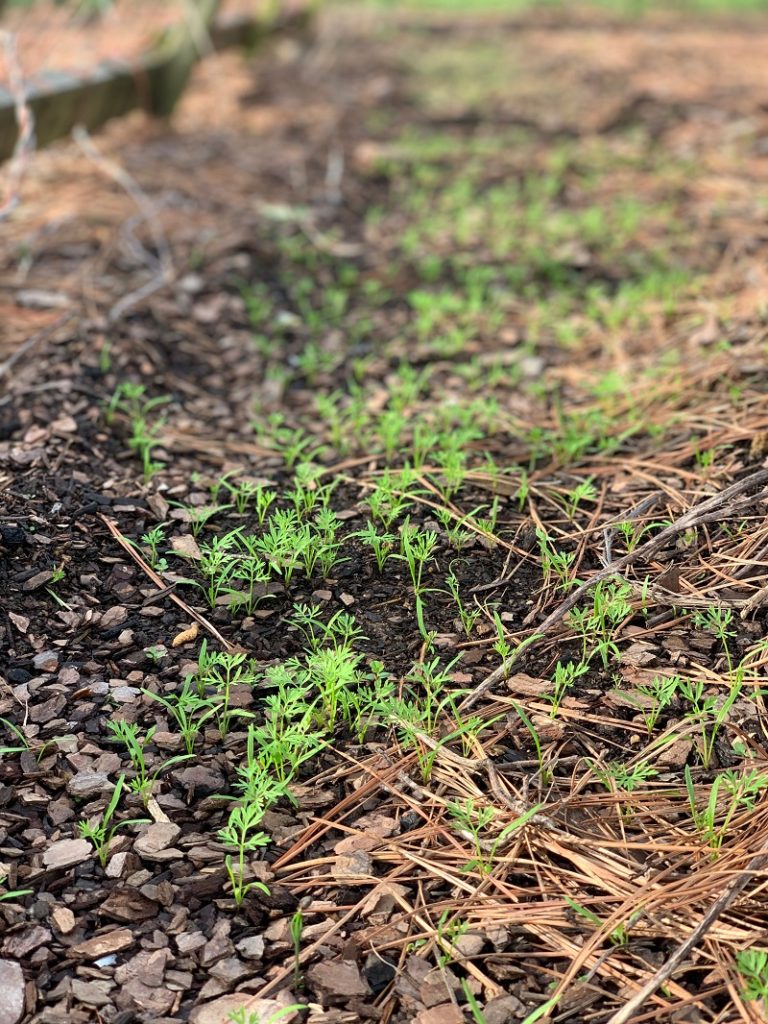Carrots. They’re among the top vegetables gardeners include in their garden plans, but many times gardeners grow dismayed when they bump into problems growing carrots.
Carrot growing problems are completely normal, and thankfully most of them can be prevented. In this podcast episode and blog post below, you’ll learn how to prevent or address the most common problems with growing carrots that many beginners face.
With a little bit of knowledge, you may just find yourself harvesting more carrots than you’ve ever imagined!
Listen to the Beginner’s Garden Podcast episode below or continue reading for all the details.[fusebox_track_player url=https://traffic.libsyn.com/secure/journeywithjill/177_EDITED.mp3]
*links below contain affiliate links; if you click through and make a purchase, this site will earn a commission at no extra cost to you.
Carrots are a favorite vegetable for many gardeners. Their sweet crunchy roots add flavor and nutrition to salads soups, roasts and more. However, it can be frustrating when your eagerly awaited carrot harvest turns out to be small and stubby roots instead of the long tapered carrots you were expecting.
Small carrots are often caused by issues with soil conditions, moisture, sunlight or spacing. The good news is that with a few simple fixes, you can get your carrot crop back on track next season. Here are the 7 most common reasons for small carrots and what to do about them:
1. Rocky, Compacted Soil
Carrots need loose, crumbly soil to support their long root growth. Heavy clay or compacted soils make it difficult for the carrots to push through and expand. Rocks and stones also interfere with the carrot’s downward growth, causing stunted roots.
Solution Improve the soil structure by mixing in 2-3 inches of compost before planting. Loosening the soil with a garden fork can also help. For quick drainage and easier growing, try raising the carrots in deep containers or raised garden beds filled with loose potting mix.
2. Insufficient Watering
Consistent moisture is critical, especially when seeds are germinating and young carrots are becoming established. Letting the soil dry out causes growth to slow or stunt.
Solution: Water the carrot bed frequently, aiming for 1-2 inches per week. Use a mulch to conserve moisture. Check soil moisture before watering again, and increase frequency during periods of heat or drought.
3. Planting Too Deep
Carrot seeds need to be planted shallow, no more than 1⁄4 inch deep. Planting too deeply can inhibit germination or result in seedlings that fail to push through the excess soil.
Solution: Sow seeds onto the soil surface, then sprinkle on a light layer of fine soil or compost. Gently water to moisten the top layer where seeds are planted.
4. Too Much Nitrogen
An excess of nitrogen fertilizer leads to lush leafy tops but stunted roots on carrots. The energy goes into foliar growth instead of the roots.
Solution: Avoid over-fertilizing with nitrogen. Moderate amounts of balanced organic fertilizer (like 5-5-5) are sufficient. Let compost be your main soil amendment.
5. Crowded Growing Conditions
When seeded too closely, carrot seedlings compete for nutrients and water as they grow. This leads to under-developed roots.
Solution: Thin carrots to 1-2 inches apart when they are 2-3 inches tall. This gives them ample room to size up.
6. Poor Sun Exposure
Carrots need at least 6 hours of direct sunlight per day. With insufficient sunlight, the tops will be small and sparse, and the roots will be stunted.
Solution: Locate your carrot bed in a sunny spot. If shade is unavoidable, try a short variety like ‘Amsterdam Forcing’.
7. Harvesting Too Late
Given enough time, carrots will eventually stop growing and become woody. The sugars convert to starches, creating a bitter taste.
Solution: Pull carrots when they reach the desired size, typically 2-3 months from seeding. Sow a new batch every 2-3 weeks for a continuous harvest.
Tips to Grow Better Carrots
Here are a few more tips to help you grow your best carrots yet:
-
Select fresh seeds of recommended varieties like ‘Danvers’, ‘Scarlet Nantes’ or ‘Cosmic Purple’.
-
Enrich soil with 2-3 inches of aged compost or rotted manure before planting.
-
Consider using row covers at seeding time to retain moisture and prevent insect issues.
-
Keep beds weed-free to reduce competition.
-
After germination, thin carrots to proper spacing for sizeable roots.
-
Water deeply and regularly throughout growth. Up to 1-2 inches per week.
-
Side dress with a balanced organic fertilizer or compost halfway through growth.
-
Harvest carrots at their peak before quality declines.
-
Rotate planting location each year to prevent disease buildup.
With the right growing conditions and care, your carrot crop can transform from small and stubby to long, straight and flavorful. Pay close attention to soil, moisture, sunlight, spacing and fertility for better results next season. It takes some patience and practice, but the sweet carrot harvest is worth it. Let those small carrots be a lesson learned, not a failure. Now you know what to improve for next year’s carrot success!

What if all my seeds sprout?
Another common problem with growing carrots is that too many seeds sprout, too close together and they fight for nutrients to grow. It’s difficult to achieve proper plant spacing upon sowing seeds because they are so small. Even long-time gardeners can get a little heavy-handed with the sowing.

When this happens, we must embrace the most tedious part of growing carrots, but it absolutely has to be done. We have to thin the sprouts. Yep, this means removing extra sprouts to ensure each remaining carrot seedling has 1-2″ of space in which to grow. If we don’t, the carrots will compete with one another and they will be drastically smaller. I’ve seen this in my own harvest. Trust me on this one. Two tiny 4″ carrots don’t compare to a meaty 8″ root.
These carrots were not properly thinned.
When harvested, their roots were only a few inches long.
Compare to these carrots, which were properly thinned to approximately 2″ between roots.
To remove extra seedlings without disturbing the delicate root system of the sprout you intend to leave, take a pair of micro-tip pruners and snip the sprouts until you have one to two inches of clear space between sprouts. When you take the time to do this, you’ll likely have some of the biggest carrots you’ve ever harvested.
Why are the greens and roots so small?
If you know your soil is fertile and loose, but you’re still looking at small carrot greens, what could be the problem? Most likely, it could be an issue of light. Carrots need full sun or very light shade. If you’ve planted them in a place where they aren’t getting this, there’s a chance you’ll have super small greens and roots.
Watch This BEFORE You Plant Carrots
FAQ
How do I make my carrots grow bigger?
Why are my carrots not getting big?
Here are some common reasons: Soil Quality: Carrots thrive in loose, well-drained soil. Compacted or heavy clay soil can restrict root growth. Ensure the soil is amended with organic matter to improve texture. Nutrient Imbalance: Excess nitrogen can lead to lush, leafy tops but poor root development.
What makes carrots short and stubby?
Transplanting carrot seedlings is the number one cause of stubby and misshapen carrots.
Why were my carrots stunted?
When carrots are exposed to excess heat, they become stunted or small. They prefer to grow in an ambient temperature of 60-70°F.Apr 10, 2024
Why are my carrots so small?
There are mainly six reasons why your carrots are so small: You are not using the right soil for growing your carrots. You are not growing the right variety of carrots. The surrounding weather is too hot for growing carrots. Your carrots might be overcrowded. Your soil has nematodes. The carrots are not getting enough water.
Why are my carrots stubby?
However it can be frustrating when your eagerly awaited carrot harvest turns out to be small and stubby roots instead of the long tapered carrots you were expecting. Small carrots are often caused by issues with soil conditions, moisture, sunlight or spacing.
Are carrot growing problems normal?
Carrot growing problems are completely normal, and thankfully most of them can be prevented. In this podcast episode and blog post below, you’ll learn how to prevent or address the most common problems with growing carrots that many beginners face.
Why do carrots split out?
Most of the time they develop like this because the young, growing root hit a rock in the growing process, causing the carrot to split out. Typically this happens in the beginning process of the carrot growing process, so this is another reason to make sure that first 6 to 8 inches are nice and loose and clear of rocks.
Why do carrots grow so long?
Another reason may be what variety of carrots you have chosen for growing. Some carrots are by nature not very long. So if you want to grow long carrots opt for a variety that is suitable for growing long. 3. Surrounding Weather is Too Hot for Growing Carrots:
Why is it so difficult to plant carrot seeds?
It’s difficult to achieve proper plant spacing upon sowing seeds because they are so small. Even long-time gardeners can get a little heavy-handed with the sowing. When this happens, we must embrace the most tedious part of growing carrots, but it absolutely has to be done.
